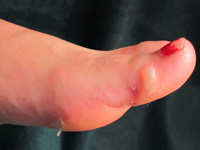By Zac Marion

It’s nothing to be ashamed of, we’ve all had them. It is estimated that one third of all runners at any given marathon will walk, or limp, away with blisters. Even veterans of the sport can end up running into this problem, literally. Well let’s take a look into what these little shoe demons are and how we can help prevent them.
It helps to first understand exactly what a blister is and how they are caused. Blisters are the body’s natural defense mechanism against friction and heat. In either case, the body produces a layer of liquid between the top layer of skin and the more sensitive layers below. Heat can cause the plasma fluid between these layers of skin to rapidly expand, thus causing the separation and fluid build-up we call blister. Continuous friction in a given area, even for a short time, can cause enough heat to form a blister. Friction can also help separate the layers of skin with force, allowing fluid to build up and create the little buggers. The idea of the blister is to create a barrier of cushioning to help protect against whichever culprit is responsible. So now that we know about what a blister is and what causes them it will be pretty easy explaining how to prevent and treat them.
There are several steps in preventing blisters, all of which have to do with reducing friction, heat and moisture. First and foremost we need to make sure that we are running in proper fitting technical running shoes. Technical running shoes are made from higher quality materials designed to breathe and help reduce moisture within the shoe. A proper fit involves two qualities, width and length. Shoes should fit snug but not tight (I know, it’s a thin line). Also, there should be enough distance, roughly a half or full shoe size, to accommodate for the swelling that will occur while running and the splaying of the toes during the toe off phase of your gait. An improper fit being too tight would cause friction between and on the tips of the toes and on the sides of the feet along the shoe’s edge. Too loose of a fit can also cause friction along the bottom of the foot as it slides around inside the shoe. Also, make sure that the heel is fitted properly.
Your second step is to make sure you are running in good socks. How do you know what a good sock is? Check out Elizabeth’s take on socks for an in depth look at the different kind of socks there are. Socks work in two ways, they wick away moisture that can soften the skin making it more susceptible to blisters and they also create a barrier to absorb all the friction occurring between your skin and the shoe. The biggest rule to socks (or any other type of running apparel for that matter) is NO COTTON! Quick educational moment; cotton is hydrophilic, meaning that it absorbs moisture and holds onto it, and it also tends to lose its shape and become loose around the foot, causing more of that pesky friction and heat. So cotton not only keeps your feet wet but it also tends to create even more friction if it loses its shape. Double dang!
The last step in defeating blisters is consumer products such as wraps, lubricants and toe caps. If you have the proper fitting shoe and the right socks then supplemental products might end up being an additional solution to the problem. I find that lubricants, such as Body Glide, Blister Shield Powder or Tri Slide, work the best for me. There are also pads such as Mueller Blister Pads and toe caps that could be used to cover the blister for more centralized or problematic areas. Unfortunately there is no single answer as to what works best to prevent blisters so come in and see us and we’ll help get you taken care of and make things as comfortable as possible.
